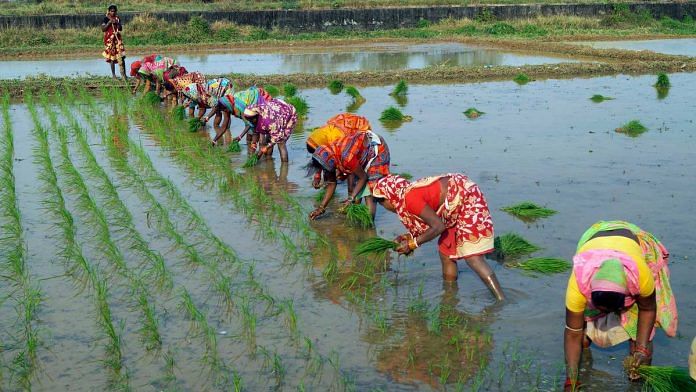New Delhi: The Union government has made substantial cuts in subsidies for food and fertilisers in the Budget for the upcoming financial year, presented by Finance Minister Nirmala Sitharaman Tuesday.
But the Budget significantly increased allocations for sectors allied to agriculture, such as fisheries and animal husbandry.
The food subsidy has been slashed by more than 27 per cent, to Rs 2,06,831 crore in the Budget estimate for 2022-23 from Rs 2,86,469 crore in the revised estimate for 2021-22. Similarly, the fertiliser subsidy has been cut to Rs 1,05,222 crore, a nearly 25 per cent drop from Rs 1,40,122 crore in the revised estimate for the previous financial year.
In 2021-22, government spending on these subsidies was higher than what was projected in that year’s Budget estimates, as the government had to step up support for the people, in the form of free foodgrains and fertiliser subsidies, in the face of the Covid-19 pandemic.
Higher commodity inflation in farm chemical inputs, leading to shortages, was another factor that pushed the government to increase fertiliser subsidies more than once last year. Hence, spending on the fertiliser subsidy in FY 2021-22 saw a whopping increase of more than 76 per cent from the original Budget allocation to the revised estimate.
However, the cut in the new budgetary allocation means that government expenditure on subsidies for crucial agricultural chemical inputs such as urea, diammonium phosphate and potash is likely to decline in the coming year.
“I think they have underprovisioned the fertiliser subsidy as the prices of fertiliser have gone through the roof. In the revised estimate stage, they will have to revise the subsidy,” T. Nand Kumar, former secretary of food and agriculture, told ThePrint.
“On the food subsidy, one has to factor in extra grain allocated this year — which may not happen next year — but there might be an increase in minimum support prices, so a slightly higher subsidy would have been appropriate,” he added.
Industry players, meanwhile, are optimistic about chemical input usage despite the cut in fertiliser subsidies.
“The introduction of drones in agriculture nutrient spraying will undoubtedly provide a boost to the agriculture input industry. Spraying by drones will help save on water while increasing the uniformity and efficacy of crop protection and nutrition products,” Rajesh Aggarwal, managing director, Insecticide India Ltd, told ThePrint.
Also read: No changes in tax slabs, deductions — FM Sitharaman gives middle class a skip in Budget 2022
PMGKAY contributed to increased food subsidy
The revised estimate for the overall food subsidy was hiked by more than 17 per cent in FY 2021-22 against the budgetary allocation, to Rs 2,86,469 crore from Rs 2,42,836 crore.
This included an increase in the revised estimate for the subsidy to the Food Corporation of India (FCI) under the National Food Security Act (NFSA) in FY 2021-22 to Rs 2,10,929 crore from the initial allocation of Rs 2,02,616 crore. However, this has now been slashed to Rs 1,45,919 crore in Budget 2022-23.
A substantial part of the increase in the food subsidy last year can be attributed to the government’s flagship pandemic food relief scheme, Pradhan Mantri Garib Kalyan Anna Yojana (PMGKAY), which has been extended multiple times.
A senior official in the Department of Food and Public Distribution told ThePrint that repeated extensions of PMGKAY — now in its fifth phase from December 2021 to 31 March 2022 — had led to additional expenditure on food subsidies.
“Earlier, increases in the food subsidy in the revised estimate were usually caused by increases in the minimum support prices for various crops, especially paddy and wheat, along with the cost surge in ‘open-ended’ purchase operations leading to grain stocks much in excess of buffer levels with FCI,” said the official.
“However, PMGKAY has also added a sizable chunk to the food subsidy,” added the official.
Boost to allied sectors
Budget 2022-23 has provided a major boost to agriculture’s allied sectors, including fisheries and animal husbandry.
While the budgetary allocation for the Department of Fisheries has seen a jump of more than 70 per cent to Rs 2,118 crore, the Department of Animal Husbandry and Dairying has registered a hike of more than 26 per cent to Rs 3,918 crore.
In the case of the fisheries department, this surge is largely down to one scheme, Pradhan Mantri Matsya Sampada Yojana, which has seen its allocation go up by more than 85 per cent to Rs 1,891 crore from Rs 1,015 crore.
The Economic Survey 2021-22, released Monday, had noted that the growth in allied sectors was in line with the recommendations of the Committee on Doubling Farmers’ Income. The committee had suggested a greater focus on these sectors to improve farmers’ income.
(Edited by Rohan Manoj)
Also read: Mental and digital wellbeing focus of FM Sitharaman’s Budget as health spend gets 16% boost



